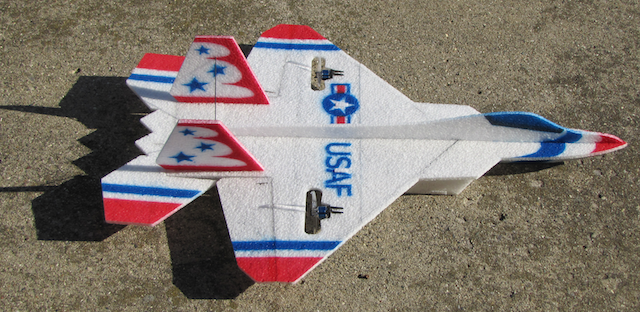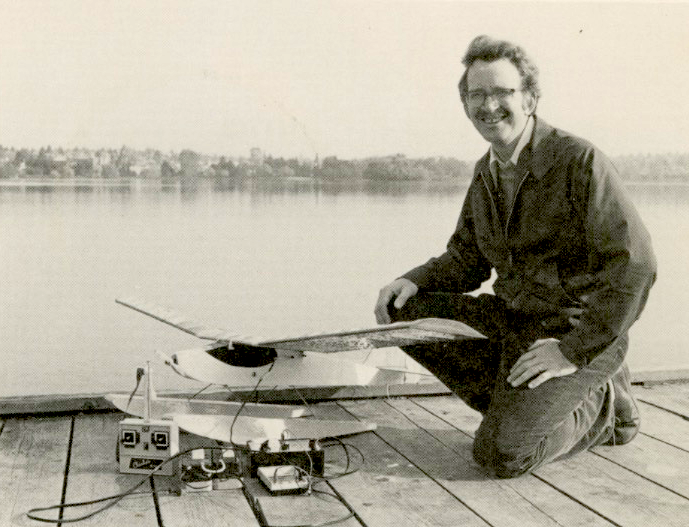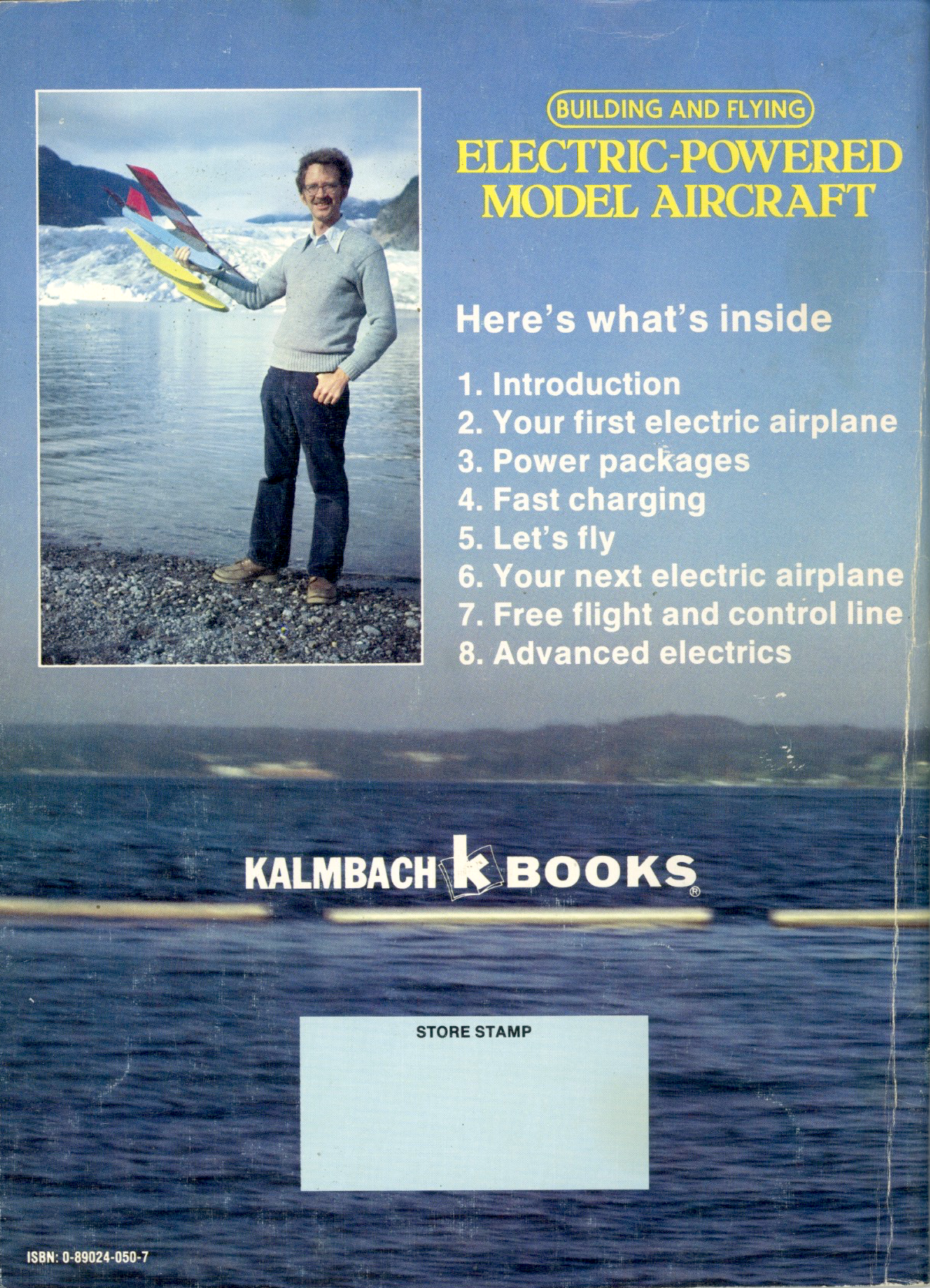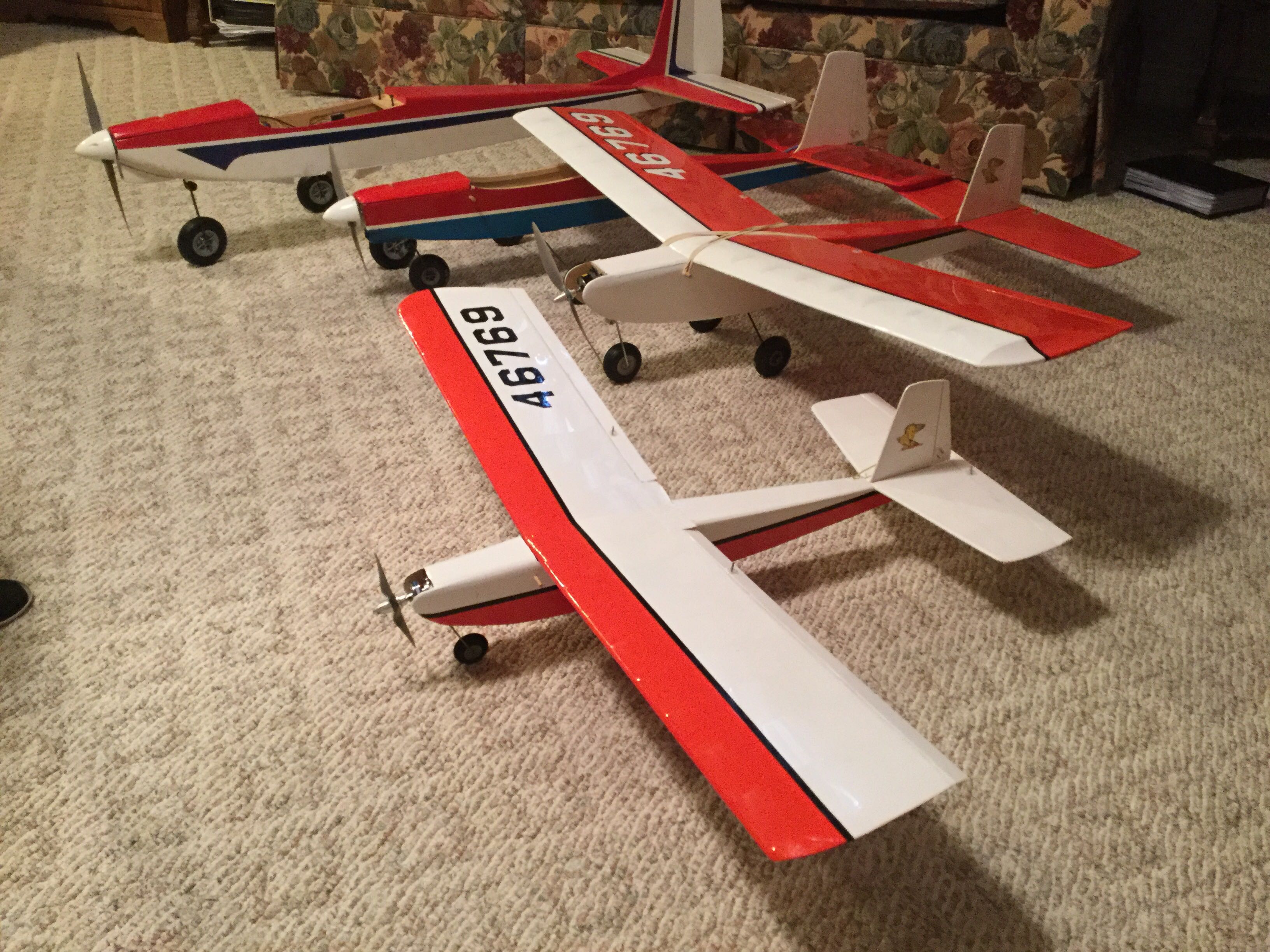 |
Flying High With Electric Power!
The Ampeer ON-LINE!
Fly the Future - Fly Electric! |
|---|
Site Table of Contents
| President: | Vice-President: | Secretary-Treasurer: |
| Ken Myers | Richard Utkan | Rick Sawicki |
| 1911 Bradshaw Ct. | 240 Cabinet | 5089 Ledgewood Ct. W. |
| Commerce Twp., MI 48390 | Milford, MI 48381 | Commerce Twp., MI 48382 |
| (248) 669-8124 | (248) 685-1705 | (2480 685-7056 |
 | ||
| Board of Directors: | Board of Directors: | Ampeer Editor |
| David Stacer | Arthur Deane | Ken Myers |
| 16575 Brooklane Blvd. | 21690 Bedford Dr. | 1911 Bradshaw Ct. |
| Northville, MI 48168 | Northville, MI 48167 | Commerce Twp., MI 48390 |
| (248) 924-2324 | (248) 348-2058 | (248) 669-8124 |
| The Next Meeting: Date: Wednesday, April 10 Time: 7:30 p.m.
Place: Ken Myers' house | ||
| FAA Reminder Reminder that you need to place your FAA number on the OUTSIDE of your aircraft. | The February 2019 EFO Meeting The planes and projects noted at the February meeting. |
| NEW WEST MICHIGAN PARK FLYER MINI F-22 Joe Hass fills us in on this fun flying plane from WMPF. | Mitch Poling, One of Our Early Electric Flight Pioneers His Early Involvement with Modeling Mitch describes his early modeling years and how he got into electrics. |
| Carl Goldberg Falcons Jim Zare describes his history with this plane. | The March 2019 EFO Meeting Highlights from the March EFO meeting. |
| Indoor Flying Season, 2018-2019, Southeast Michigan Dates and times for Indoor flying in our area. | Skymasters' Electric Night Fly and Fly-in Info on this upcoming annual event. |
| Upcoming 35th Annual Mid-America Electric Flies 2019 Info on this upcoming annual event. | |
Starting this year, your FAA Number is required to be visible on the OUTSIDE of your aircraft. The Federal Government is afraid that we'll boobytrap our planes with explosives to go off if they have to open a hatch. 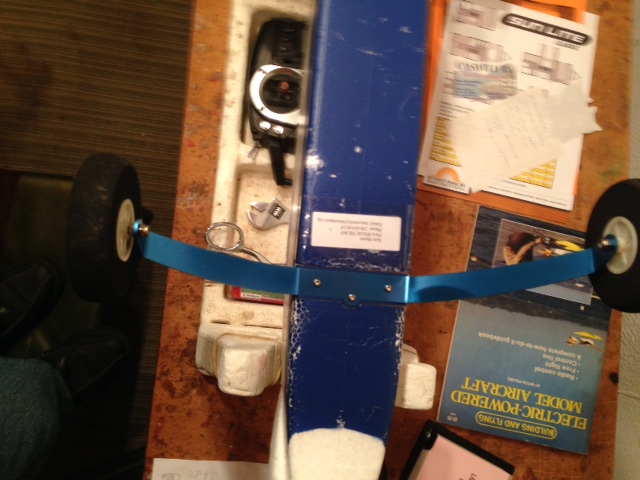 I am using printer labels covered with clear packaging tape to provide the FAA number. I'm placing the label on the bottom of the aircraft. 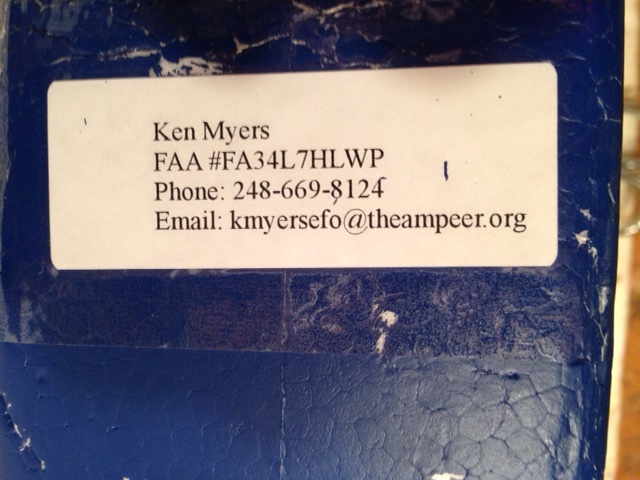 The close-up photo, on the bottom of the FMS Super EZ trainer, shows that I put my name, the FAA number, and also my phone number and email address on the label. Previously, all that information was on a label on the inside of my aircraft. I will add required FAA labels to the bottom of each plane as I get it ready for flying season this year. The February 2019 EFO Meeting The February meeting was held on the 13th. February had a lot of snow and travel was difficult, but there still was a pretty good turn out. Thanks for coming guys!!! 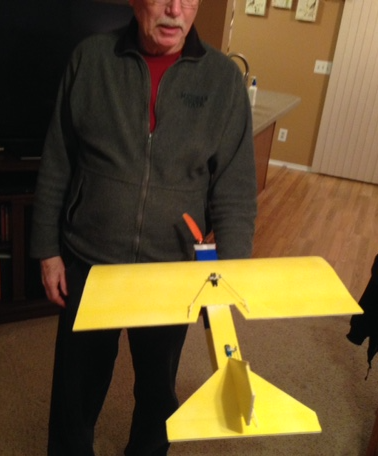 EFO vice-president, Richard Utkan, lead off the evening describing his single motor version of the FliteTest Super Bee. 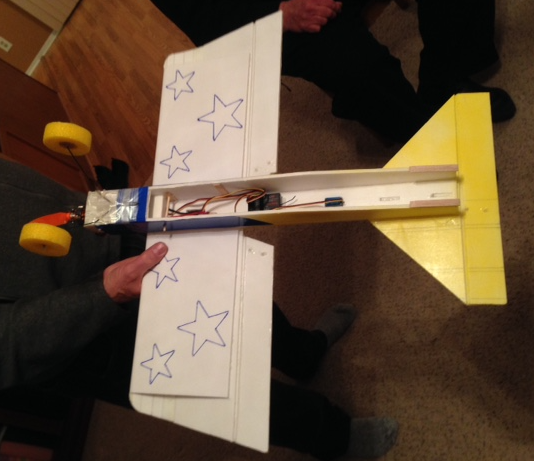 His version features a somewhat extended fuselage. It is powered by a single 2S LiPo and Tower 2100 1400Kv motor. The power system provides about 100 watts in. The wheels are made with foam from pool tube floats. He noted that it flies very well. Keith Shaw shared his recently modified DFW T28 "FLOH". 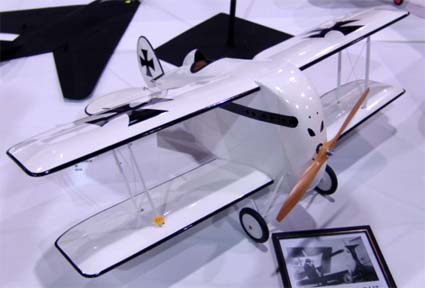 The above photo shows the FLOH as it appeared in April of 2007 at the Toledo RC Expo. 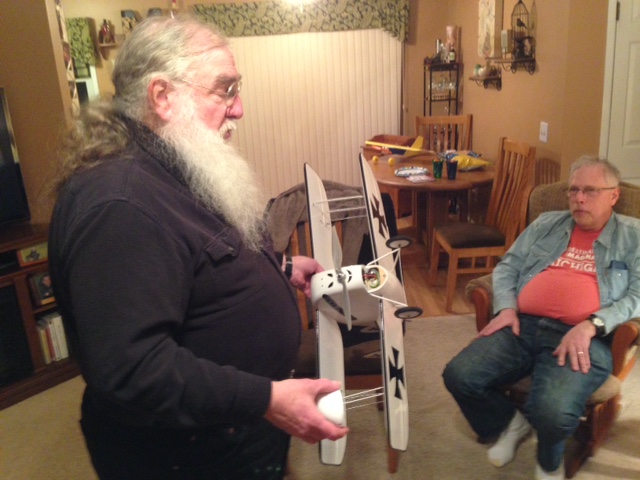 Keith recounted the story as to why it never went into production. He noted that the full-scale prototype had extremely poor downward visibility and landed too fast for the pilots of that time. He flew about twenty or so flights on his model, and then, literally, hung it up because it suffered from terrible adverse yaw and was quite unpleasant to fly. 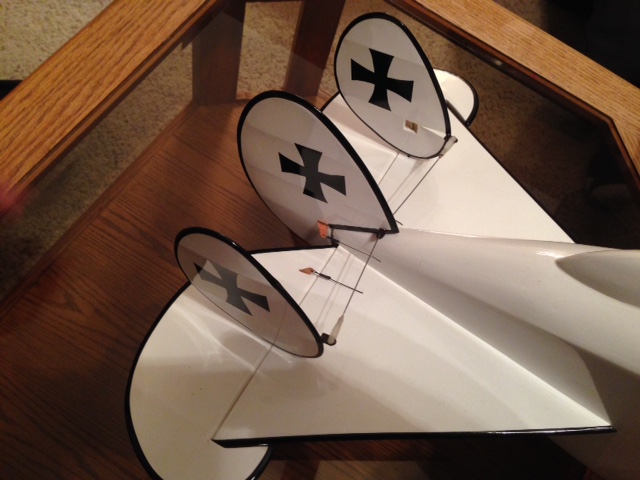 To see if he can get it to fly better and eliminate the adverse yaw, he has added two more rudders to the tailplane. 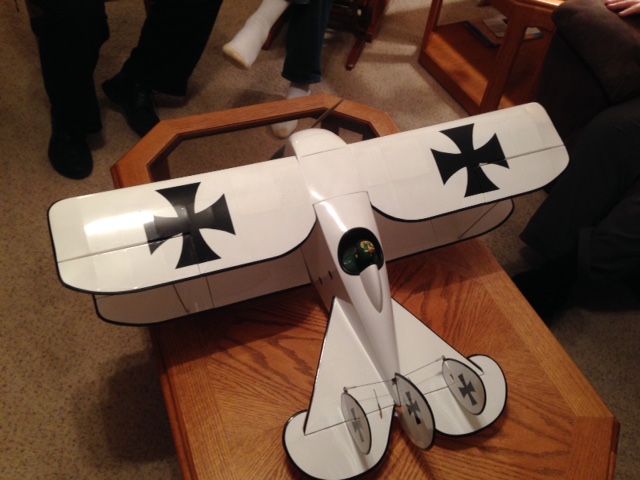 While it is no longer 'scale', he hopes to have a much better flying model. 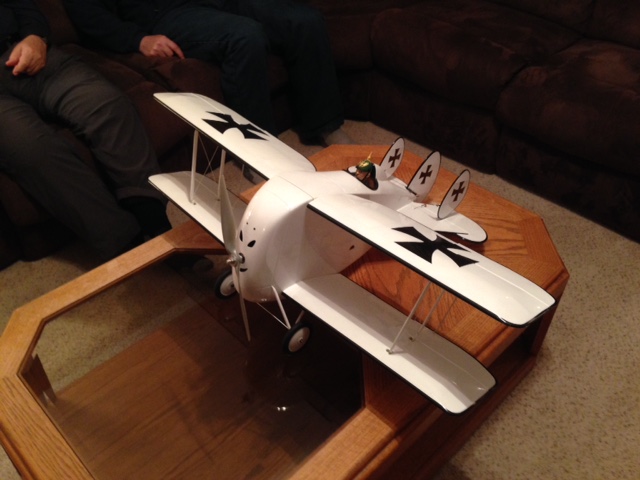 One of the most distinguishing features of this plane is the way that the cowl looks like a face. Ken noted that he liked the 'face' on the cowl so much that he "borrowed" the look to put on a a cowl that he made for an ARF conversion back then. 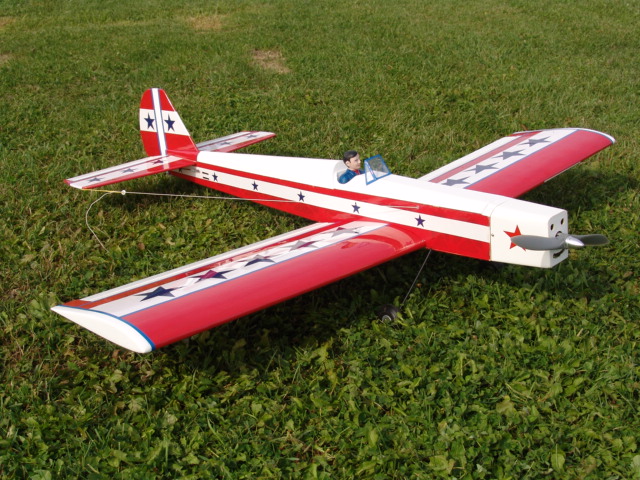 The plane was a Dymond Modelsport Ltd. Flite 40 low-wing ARF. Yikes, it wasn't red and yellow! The plane was assembled in 2007 as well. After the original cowl, that Ken made, was destroyed in a motor explosion, really, a second cowl was made that incorporated the face. Keith also noted that he'd been working on a model of a KATY that he'd hoped to enter into Toledo this year. Ken showed photos of the KATY project to the group. Unfortunately, Keith will not be able to complete the project before Toledo this year. 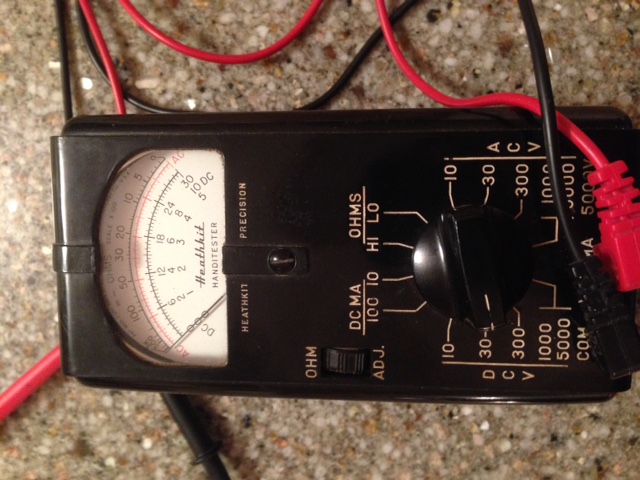 Bob Blau shared a Heathkit multi-meter that he built 'long ago'.  He also brought along a new Fluke multi-meter that was made for the Chinese market. He was able to pick it up at a very good price. Snacks were furnished and everyone had a good time discussing the various aspects, past and present, of our great hobby. NEW WEST MICHIGAN PARK FLYER MINI F-22
West Michigan Park Flyers (WMPF) is one of the many "cottage industry" companies that keep supplying modelers with great products. A while ago I did a review of their EPP differential thrust F-22 in optional Thunderbird colors. That write up appeared in Park Pilot. It has become one of my "Go To" aircraft when I want to knock off the rust and have some fun with an incredibly durable airframe. The placement of the motors and props coupled with the differential thrust gives it an incredible flight envelop. 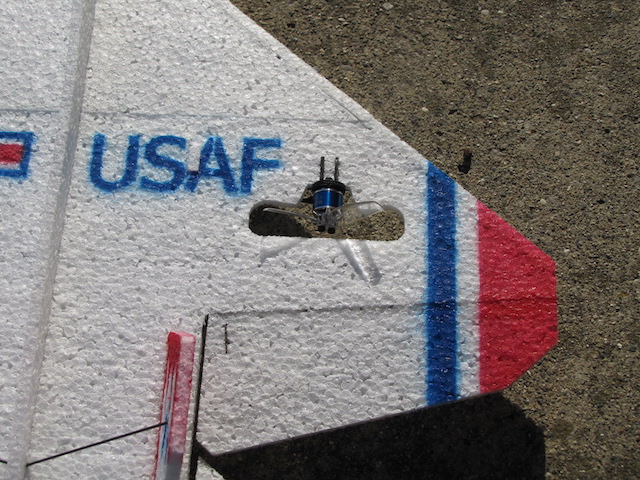 When I heard that Greg and Barb Markley, the owners of WMPF, were coming out with a mini version I placed my order. I built kit 3. While, at this writing, the MINI F-22 is not one the WMPF website it is available. Send the Markleys an email greg@wmparkflyers.com or give them a call 616-667-1809 (Eastern Time) for pricing and availability. Just like its big brother a complete package (motors, props, ESCs, BEC, servos) is available from WMPF. Foam Tac, regular medium CA and a little bit of 5 minute epoxy are the adhesives of choice. All of the carbon fiber, wood and wire parts are included. It goes together very quickly as the control surfaces are pre- hinged. In general I followed the instructions for the larger version that are available on their website. The only important building tip I can offer is to not place the fuselage bottom in place until all of the electronic equipment is installed. It is just a lot easier. Keep everything as far forward as possible as I needed to add 1/4 ounce of weight in the nose for proper CG. Differential thrust for yaw is what really makes the F-22 fun. The differential thrust is accomplished by mixing throttle and rudder. I used one of the new Spektrum receivers that does not require a binding plug or have external antenna. On the first flight have someone else launch it. Just hold on to the fuselage top just behind the canopy. Start out with low rates, especially on the yaw function. The motors spool up to about 30,000 RPM so the "rudder" is very effective. 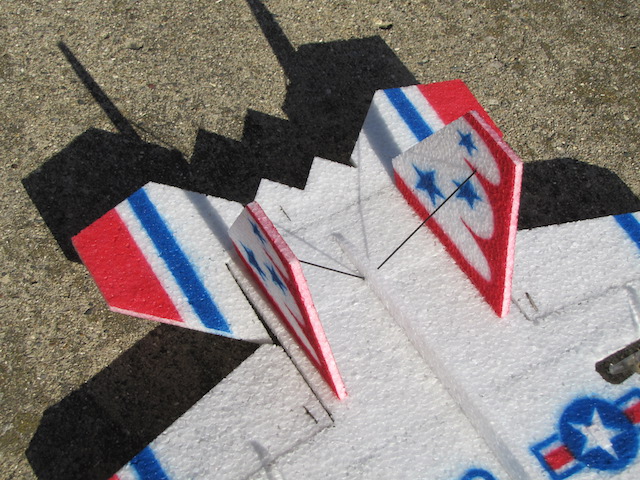
This photo demonstrates why the word rudder is in quotation marks. This is a little rocket ship that is equally comfortable indoors or out. It has a higher wing loading than the big one, so it won't fly quite as slow but will still do incredible high alpha maneuvers. It will also accelerate vertically. It is just neat! Flight times are about 5 minutes with a 3S 450MAH Li Po. The MINI F-22 will be a great addition to your fleet. The larger F-22 will fit in your back seat. The MINI F-22 will almost fit in your glove compartment! Joe Hass
West Michigan Park Flyers
Specifications:
Needed to complete
Mitch Poling, One of Our Early Electric Flight Pioneers His Early Involvement with Modeling
The above is the photo of Mitch from the inside cover of his book BUILDING AND FLYIG ELECTRIC-POWERED MODEL AIRCRAFT, Kalmbach Books, copy-write 1984. Mitch and I have been in contact for decades. I have always considered him one of my great mentors. Even though we've never physically met, or flown together, I still consider him one of my good flying buddies to this day! The following information was provided to me by Mitch. My early model building experience was in Alaska, my father and mother were Alaska Native Service teachers. I was six years old in 1947, when I "helped" my Dad build a really nice Spitfire rubber powered model - that sparked my interest, and I progressed to gluing an ROG model to the plans in 1948. Then in 1949 we were in an Eskimo village, no way to get model planes and supplies. So - I made kites, which turned out quite well. I also had a subscription to Flying Models, I would look at the plans and dream. We moved to Juneau in 1951, there was a hobby shop there, and my modeling career was launched. I built some of the Monogram quick build rubber powered models in 1951-52, but they didn't fly very well. I built several of the Comet rubber powered scale models, which basically did a powered glide, but they looked really nice. My very first successful flying model was a Comet Sparky rubber power, about 1953. I started in U control with a Jim Walker model in 1954, powered by an OK Cub .049. This model flew very well. There was a dry spell in my model flying from 1959-64 during the college years. I picked up on the U control again in 1964, flying, in all places, in Nigeria when I was a Peace Corps volunteer. I used methyl alcohol that was used for the Tilley lamps (we had no electricity). The engines ran rough on it, but well enough to fly! Back to the US in 1967, and I started in RC with the Ace pulse rudder system. I was a graduate student at the University of Washington, Seattle, and flew at Marymoor Park. I liked the small .049 models, and eventually moved to two channel. The only problem was the noise and the mess - the little half A engines had a very high pitched whine that was hard on the ears, and the oil soaking was tough on the airplanes. Then I met Sandra in 1969. My first efforts in electrics were inspired by Sandra - she asked if there was any way to fly the models without the noise and mess. That was in 1971 - and the Mattel Super Star was a natural - I installed the Ace pulse rudder RC in it, but my first tries with it were powered sink - the little stock 100 mAh nicads didn't have the necessary power. The AA GE (later Sanyo) nicads were the breakthrough, plenty of power and duration. What a feeling it was to see that first flight go climbing up into the sky! Clean and quiet, the only way to fly! My next electric, after the Super Star, was the Ken Willard Schoolboy, powered by a rewound Plymouth windshield washer motor and six GE AA nicads. It was a fantastic flyer, the best! After that I converted the Dick's Dream from Ace RC, same setup, 6 AA GE nicads and the rewound washer motor. It flew very well, was crash proof, and was the standard trainer I used to teach my flying buddies who were interested in electrics. I taught Sandra to fly with it, at last, she liked my hobby! To refresh your memory, here are photos of the front and back covers of Mitch's book, which I still cherish! KM 
Carl Goldberg Falcons
Jim Zare is another electric flight pioneer. Wow, heard from two within one month! Ken, I loved the article on the Goldberg Falcons. I have a long history with these models. I flew my first Junior Falcon with a World Engines digit midget and a Cox 049 in 1970. It was my first successful glow powered model. I basically learned to fly with this plane. I got to know Carl Goldberg when I authored the Silent Power column in RCM. He came to the Toledo Show every year. He once told me that the Jr. Falcon and Jr. Skylark were designed to use scrap wood and fit in an inexpensive 18" box. He also had a fond place in his heart for the Falcons. He sold a ton of them. I currently have a Sr Falcon ARF from Hobbico from 2005 and Falcon 56 from a Vintage RC kit. Under the brand Electric Model Design, I produced and sold Jr Falcon and Jr Skylark laser cut kits in the late 90's early 20's for speed 400 motors and Nicads. Last year I dusted off the CAD files and redesigned the Jr. Falcon for an E-Flite Park 340, 6x4.5 APC prop, a 3 cell 800 mAh pack, full four Channel and a Magnetic hatch. It weighs 15 oz. and flies great. It is much better than the old speed 400 versions. I actually like it better than the Falcon 56. It rolls, flies inverted, does big loops and yet slows down for long graceful glide back to the field after a 8 to 10 minute flight. I liked it so much that I enlarged it 33% to create a Falcon 50 with a Park 480 and a 3S 2200 mah pack. This also flies great and will ROG from a grass field. Bob Holman is going to produce and sell these. I would be willing to write an article for The Ampeer on these models. Let me know what you think. Jim Zare 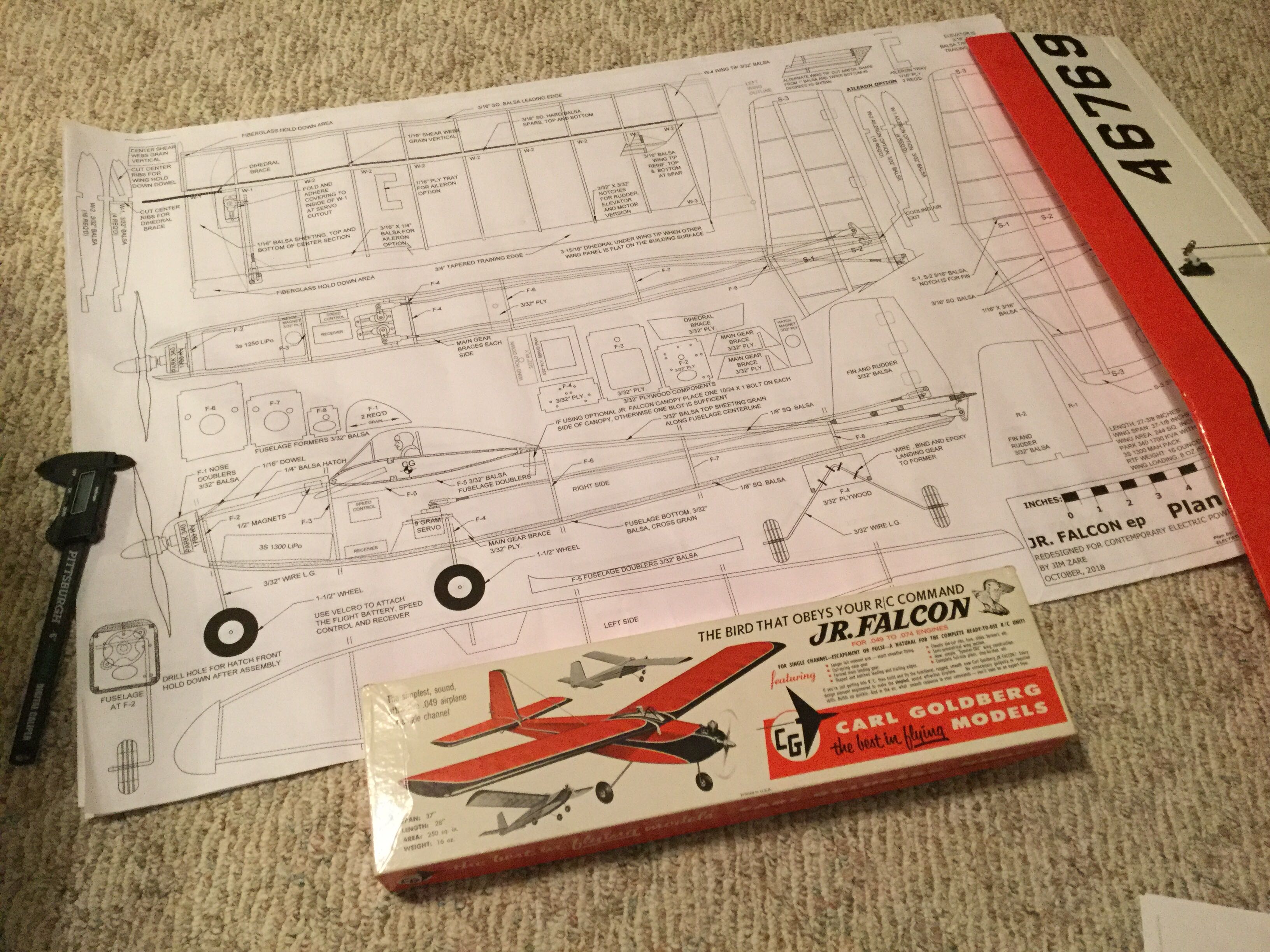 I wrote back to Jim and told him I thought that would bar a great idea. I am looking forward to sharing it with all of you! KM The March 2019 EFO Meeting The Wednesday, March 20, EFO meeting was lightly attended. The meeting had to be moved from the 2nd Wednesday of the month to the 3rd Wednesday of the month because Ken was suffering from a bad, bad cold through the second week, as well has having to have two teeth extracted! Owen Morgan brought along the Carl Goldberg Gentle Lady that he had under construction. He picked up the kit on E-Bay. 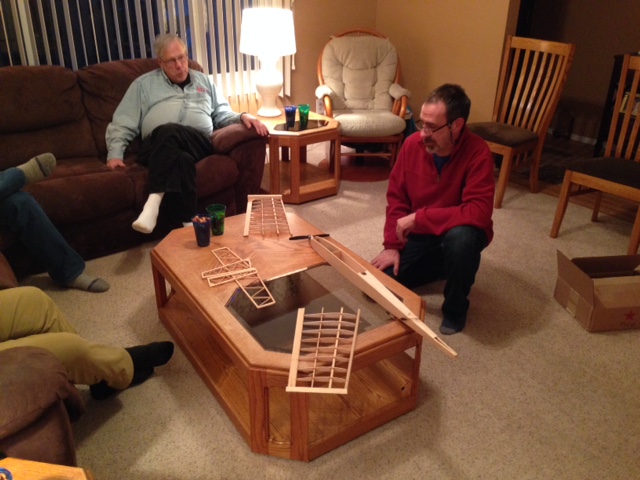 He had us guess what kit it was and Rick Sawicki nailed it. Ken noted that he should have known what it was, because he flew his mid-1980s version to first place in a three flights on a charge event in Lakeland, Florida. We are all looking forward to seeing Owen's version fly soon. There was an ad for JET brand CA in Owen's kit. The some of the members noted a disappointment that JET brand CA is no longer available through Tower Hobbies. Ken showed two 'new' bottles of JET that he's had in his refrigerator for two years, and its consistency is just like new! Indoor Flying Season, 2018-2019, Southeast Michigan Tuesdays, October 30 through April 16, 10 a.m. - 1 p.m.
Ultimate Soccer Arenas
Single Flying Session - $10
All pilots MUST have proof of AMA Membership
Spectators Welcomed
More Information is available here.
Support your local hobby shop because they support us! Wednesdays, November 7 through April 24, 12:30 p.m. - 2:30 p.m. Legacy Center
Drop in Flying Session - $10 Spectators Welcomed and free There may be exceptions or changes around the holidays.
Return to "What's In This Issue" Skymasters' Electric Night Fly and Fly-in
The Skymasters' Annual Electric Night fly will be held on Saturday, June 8 and the electric fly-in is on Sunday, June 9. More details will follow when they become available. 35th Annual Mid-America Electric Flies 2019
The 7 Mile Rd. Flying Site, Salem Twp., MI
Contest Directors are:
Flying both days at the Midwest R/C Society Flying Field - 7 Mile Rd., Salem Twp., MI Registration: 9 A.M. both days
Pilot Entry Fee: 18 and over, $15 Sat. - $10, Sunday, (ask about the family rate),
Saturday's Awards
Sunday's Awards
Planes Must Fly To Be Considered for Any Award
Open Flying Possible on Friday
Potluck picnic at the field on Saturday evening. Come and join us for two days of fun and relaxed electric flying. Come, Look, Listen, Learn - Fly Electric - Fly the Future!
Special Events Again this year for NCM (Not Conventional Materials) aircraft
Foam Flurry for NCM aircraft:
Most Unique NCM Aircraft Award:
To locate the Midwest R/C Society 7 Mile Rd. flying field, site of the Mid-America Electric Flies, look near top left corner of the map, where the star marks the spot, near Seven Mile Road and Currie Rd. Link to the map. The field entrance is on the north side of Seven Mile Road about 1.6 Miles west of Currie Rd.
Because of their convenient location and the easy drive to the flying field, the Comfort Suites and Holiday Inn Express in Wixom, MI have been added to the hotels’ listing. They are only 10 miles northwest of the field and located near I-96 and Wixom Road. See the map-hotel .pdf for more details.
To Reach Ken Myers, you can land mail to the address at the top of the page. My E-mail address is: KMyersEFO@theampeer.org |
